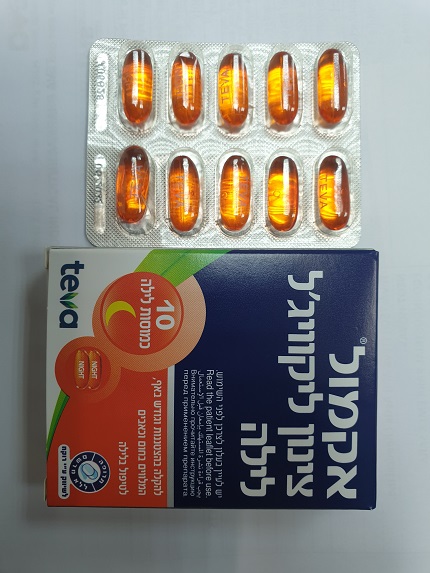Quest for the right Drug

אקמול צינון ליקוויג'ל לילה ACAMOL TSINUN LIQUIGEL NIGHT (CHLORPHENIRAMINE MALEATE, PARACETAMOL, PSEUDOEPHEDRINE AS HYDROCHLORIDE)
תרופה במרשם
תרופה בסל
נרקוטיקה
ציטוטוקסיקה
צורת מתן:
פומי : PER OS
צורת מינון:
קפסולות ממולאות נוזל : CAPSULES LIQUID FILLED
עלון לרופא
מינוניםPosology התוויות
Indications תופעות לוואי
Adverse reactions התוויות נגד
Contraindications אינטראקציות
Interactions מינון יתר
Overdose הריון/הנקה
Pregnancy & Lactation אוכלוסיות מיוחדות
Special populations תכונות פרמקולוגיות
Pharmacological properties מידע רוקחי
Pharmaceutical particulars אזהרת שימוש
Special Warning עלון לרופא
Physicians Leaflet
Overdose : מינון יתר
4.9 Overdose Signs and symptoms Paracetamol Liver damage is possible in adults who have taken 10 g or more of paracetamol. Ingestion of 5 g or more of paracetamol may lead to liver damage if the patient has risk factors (see below). Risk Factors: If the patient A. Is on long term treatment with carbamazepine, phenobarbital, phenytoin, primidone, rifampicin, St John's Wort or other drugs that induce liver enzymes. Or Acamol Tsinun Liquigel Night SK 08.2024 7/8 B. Regularly consumes ethanol in excess of recommended amounts. Or C. Is likely to be glutathione deplete e.g. eating disorders, cystic fibrosis, HIV infection, starvation, cachexia. Symptoms Symptoms of paracetamol overdosage in the first 24 hours are pallor, nausea, vomiting, anorexia and abdominal pain. Liver damage may become apparent 12 to 48 hours after ingestion. Abnormalities of glucose metabolism and metabolic acidosis may occur. In severe poisoning, hepatic failure may progress to encephalopathy, haemorrhage, hypoglycaemia, cerebral oedema, coma and death. Acute renal failure with acute tubular necrosis, strongly suggested by loin pain, haematuria and proteinuria, may develop even in the absence of severe liver damage. Cardiac arrhythmias and pancreatitis have been reported. Haemolytic anaemia (in patients with glucose-6-phosphate dehydrogenase [G6PD] deficiency): Haemolysis has been reported in patients with G6PD deficiency, with use of paracetamol in overdose. Management Immediate treatment is essential in the management of paracetamol overdose. Despite a lack of significant early symptoms, patients should be referred to hospital urgently for immediate medical attention. Symptoms may be limited to nausea or vomiting and may not reflect the severity of overdose or the risk of organ damage. Management should be in accordance with established treatment guidelines, see BNF overdose section. Treatment with activated charcoal should be considered if the overdose has been taken within 1 hour. Plasma paracetamol concentration should be measured at 4 hours or later after ingestion (earlier concentrations are unreliable). Treatment with N-acetylcysteine may be used up to 24 hours after ingestion of paracetamol, however, the maximum protective effect is obtained up to 8 hours post-ingestion. The effectiveness of the antidote declines sharply after this time. If required the patient should be given intravenous N-acetylcysteine, in line with the established dosage schedule. If vomiting is not a problem, oral methionine may be a suitable alternative for remote areas, outside hospital. Management of patients who present with serious hepatic dysfunction beyond 24h from ingestion should be discussed with the NPIS or a liver unit. Pseudoephedrine Symptoms Overdose may result in: Hyperglycaemia, hypokalaemia, CNS stimulation, insomnia; irritability, restlessness, anxiety, agitation; confusion, delirium, hallucinations, psychoses, seizures, tremor, intracranial haemorrhage including intracerebral haemorrhage, drowsiness in children, mydriasis, palpitations, tachycardia, reflex bradycardia, supraventricular and ventricular arrhythmias, dysrhythmias, myocardial infarction, hypertension, vomiting, ischaemic bowel infarction, acute renal failure, difficulty in micturition. Management Necessary measures should be taken to maintain and support respiration and control convulsions. Catheterisation of the bladder may be necessary. If desired, the elimination of pseudoephedrine can be accelerated by acid diuresis or by dialysis. Chlorpheniramine Symptoms and signs The estimated lethal dose of chlorphenamine is 25 to 50mg per kg body weight. Symptoms and signs include sedation,paradoxical excitation of the CNS, toxic psychosis, apnoea, convulsions, anticholinergic effects, dystonic reactions andcardiovascular collapse including arrhythmias. Treatment Symptomatic and supportive measures should be provided with special attention to cardiac, respiratory, renal and hepatic functions, and fluid and electrolyte balance. If overdosage is by the oral route, treatment with activated charcoal should be considered provided there are no contraindications for use and the overdose has been taken recently (treatment is most effective if given within an hour of ingestion). Hypotension and arrhythmias should be treated vigorously; CNS convulsions may be treated with I.V. diazepam.Haemoperfusion may be used in severe cases.

שימוש לפי פנקס קופ''ח כללית 1994
לא צוין
תאריך הכללה מקורי בסל
לא צוין
הגבלות
לא צוין
מידע נוסף
עלון מידע לצרכן
12.09.22 - עלון לצרכן עברית 26.02.23 - עלון לצרכן אנגלית 26.02.23 - עלון לצרכן עברית 26.02.23 - עלון לצרכן ערבית 21.03.24 - עלון לצרכן עברית 29.05.24 - עלון לצרכן אנגלית 29.05.24 - עלון לצרכן עברית 29.05.24 - עלון לצרכן ערבית 12.08.24 - עלון לצרכן עברית 12.09.22 - החמרה לעלון 26.02.23 - החמרה לעלון 21.03.24 - החמרה לעלון 12.08.24 - החמרה לעלוןלתרופה במאגר משרד הבריאות
אקמול צינון ליקוויג'ל לילה